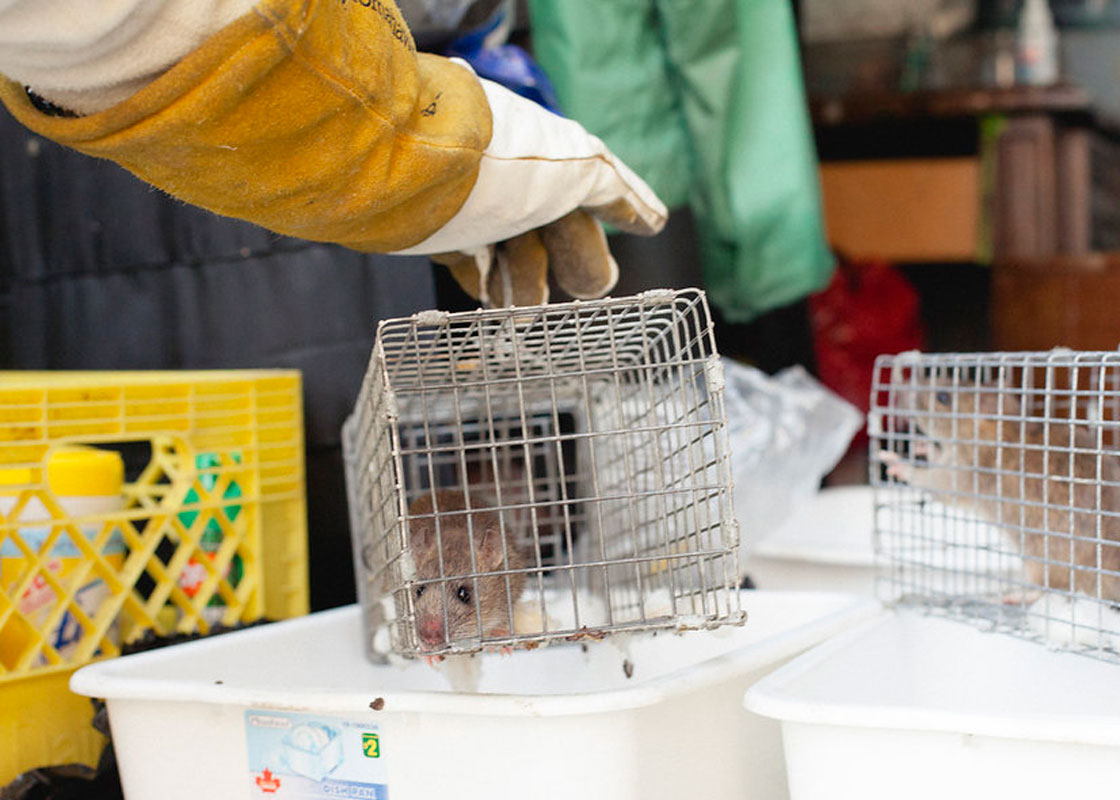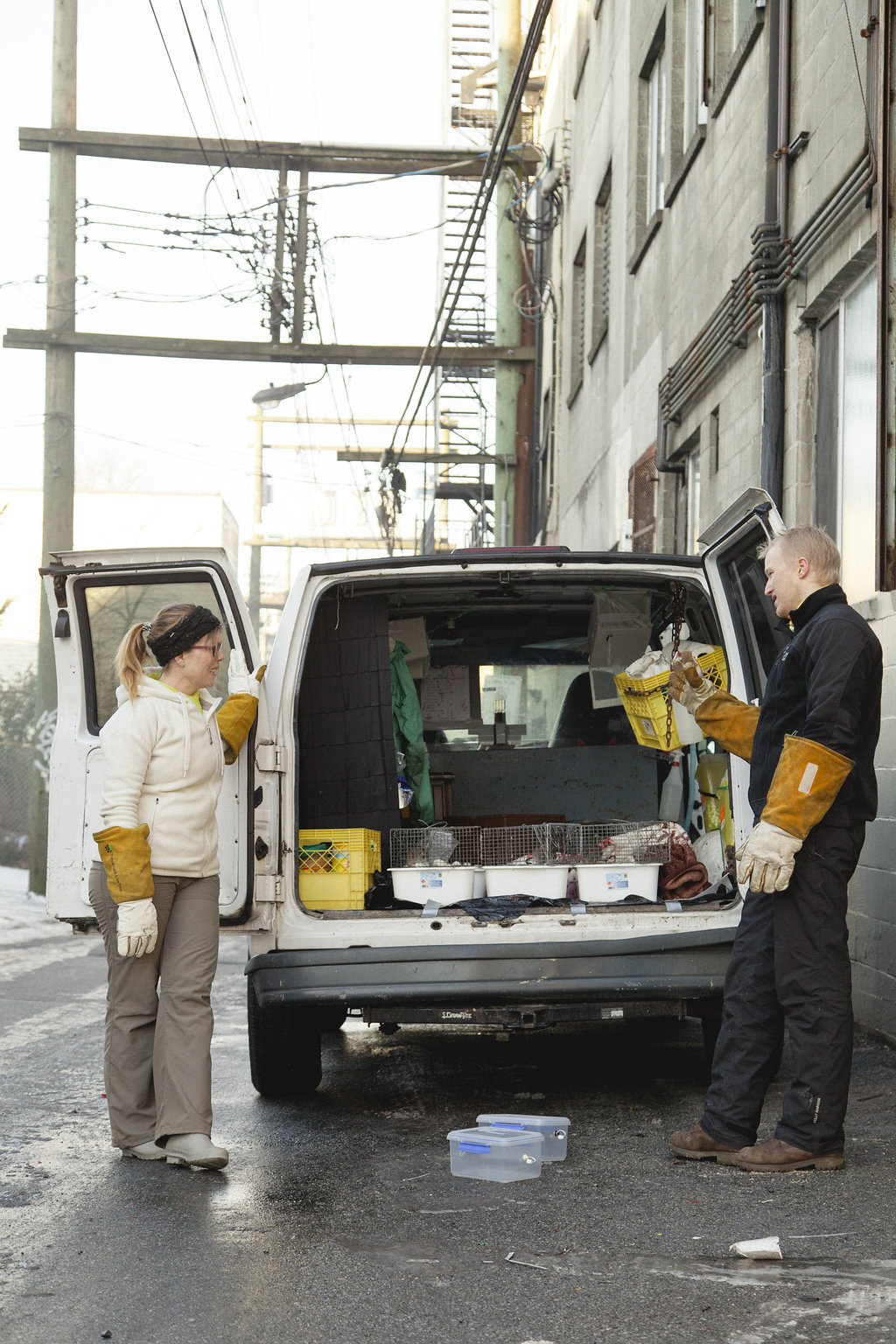It takes two to catch a rat.

That’s what Kaylee Byers learned the first time she was in the back of her team’s van, opening up a trap to get at the rat stuck inside.
“We thought you could just open the cage and reach in with the gloves and pull one out. And we did that, and the first rat immediately escaped inside the van,” she said.
“It lived there for two weeks. His name was Harold.”
The research team from the University of British Columbia got better at it, though — eventually collecting around 1,400 rats over nine years from Vancouver’s Downtown Eastside.
“After some time, we realized that we needed to tag-team the rat to get it fully trapped,” she explained.
Byers, the regional deputy director for the British Columbia Canadian Wildlife Health Co-operative, is one of the people involved with the Vancouver Rat Project, a program that studied Vancouver rats’ health, their movement and their ability to carry disease.
Their research suggests an entire hidden ecosystem in our cities, one with the potential to affect human health.
Human health
When the project began, the researchers chose to study the impoverished Downtown Eastside of Vancouver.
“The focus was, essentially, if we’re concerned about rats and the things that they carry making people sick, then we should study a population that may be more likely to come into contact with rats due to issues of affordability for housing,” Byers said.
“People that are intravenous drug users may have increased contact with rats, and of course, people that are impoverished or homeless as well,” said Jamie Rothenburger, an assistant professor in the University of Calgary’s faculty of veterinary medicine.
Rat-related disease is a real concern.
The Black Death was blamed on rats (specifically on bacteria carried by fleas carried by rats), and there are still occasional outbreaks of plague in Africa and parts of South America, according to the World Health Organization.
But rat-associated diseases are rarer in North America, as people have less contact with the animals. Still, there are occasional cases of leptospirosis, and pet rats helped cause an outbreak of Seoul virus in 2017.
Los Angeles had a typhus outbreak in 2018 and early 2019, which, again, was blamed on rat fleas — including rats infesting homeless communities as well as city hall.
WATCH: Would you adopt a rat? Vancouver wants you to try

Rothenburger, who also worked on the Vancouver Rat Project, thinks that rat-related diseases might be underestimated in North America, as their symptoms can often be non-specific, like fever.
“It may not be the first thing that physicians think of when someone from one of these sort of disadvantaged communities might come in for a health concern,” she said.
“I think the general consensus is that probably the rat-associated diseases in urban developed countries are probably under-recognized.”
Rat-catching
Rats are wary of new things in their environment, Byers said, which makes them tricky to catch.
To make the rats comfortable, the team would bait a trap with a peanut butter-oat ball and leave it for a week, with the door jammed open so rats could walk freely in and out without anything bad happening.
Then, they set the trap — essentially a wire cage. Every day, they drove around in a van to pick up the rats. Once they had them in the van, researchers would sedate them, take some urine and blood samples, put a numbered tag in their ear, and brush them for fleas. Then, after getting some rehydration solution and waking up, the rats would be put back where they came from.
Some rats really loved the food. One, that the team called “Lazarus” because he seemed dead when they caught him, came back every day for a snack.
“I didn’t even have to look at his ear tag anymore because he would rub his nose on the bottom of the cage and he lost his fur there,” Byers said. “And so I would just look and instantly see this little triangle of fur missing on his forehead and know that it was Lazarus.”
Sponges and mixing bowls
The blood, flea and urine samples, as well as the ear tags, taught the researchers a lot about how rats behave in the urban environment. So did autopsies performed on an earlier group of rats, who were killed for dissection instead of being set free.
Vancouver’s rats do indeed carry disease, according to the research. They carry the bacteria that causes leptospirosis — an infection that, if left untreated, can cause kidney or liver failure. They carry E. coli and salmonella.
And, as some of the most recent research found, sick rats are even more likely to carry these pathogens than healthy ones.
Often, these pathogens don’t actually infect the rats themselves.
“Rats, they can not only carry lots of different things, but they can also act as a sponge. So they can move through the environment and pick up these things like E. coli, salmonella that they might just come into contact with in the environment,” Byers said.
Worryingly, the researchers also found drug-resistant pathogens like MRSA and MRSP on their downtown Vancouver rats.
WATCH: The Vancouver Rat Project (interview filmed in 2014)

Because rats can carry many things, and because bacteria tend to share genes like drug resistance between each other, the concern is that rats could act as a “mixing bowl,” creating more dangerous diseases, Byers said — though there hasn’t been much research yet into this phenomenon in rats.
The researchers also studied how rats move through the city, so they could better learn how diseases might spread. It turns out rats don’t actually leave their block all that often, Byers said. So, they noticed different rates of disease-causing bacteria on different city blocks.
“One city block could have 60 per cent of the rats carrying leptospira,” she said. “But the next block over might have few or no rats carrying leptospira.”
Human activity can change the rats, too. The researchers simulated pest control in a block, and found the remaining rats were actually more likely to carry some of these pathogens than the larger rat population was before.
“It just hints at that human actions or any actions that alter stable colonies can have these unpredictable consequences,” Byers said. In an upcoming phase of work, Rat Project researchers will partner with the City of Vancouver to research rat control strategies, she said.
Rats are part of our urban ecosystem, Byers thinks, and it’s important to study how they affect us.
“I generally feel that when you just focus on humans alone, you’re really just looking at the tip of the iceberg,” she said.
“You lack so much information about the dynamics of what’s going on around you that you really aren’t able to effectively address the root issues that we see in people.”
She also thinks that rats will remain part of her life for a while yet. “They’re hilarious animals and I also appreciate the impact they have on people,” she said.
“I have a deep appreciation for rats.”




Comments